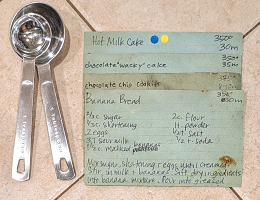0.3 Fractions
Applications
We use seed mixes to rehabilitate areas that have been disturbed and to enhance habitat for wildlife with nutritious plant species. A planting prescription will often give us ratios of different species to include in a mix and, in general, we will broadcast spread seed at a rate of about 10 pounds per acre.
If a seed mix includes 2 pounds of bluebunch wheatgrass, 1 pound of prairie junegrass, 3 pounds of Idaho fescue, and 2 pounds of sulfur buckwheat - what fraction does each species make up in this mix? What fraction do the grasses make up? How many pounds of total seed will be used on a 5-acre restoration site? How many pounds of this will be grass seed?
If these calculations feel a little foreign to you right now, this chapter give you a chance to review fractions and get comfortable working with them.

Working with fractions is one of the most hated/feared/avoided topics in lower-level mathematics. If you've always struggled with fractions, now is the time to face them. Don't avoid them and hope they'll go away. (They won't.) We'll start with the basics of what fractions are and proceed from there.
Writing Fractions
A fraction describes equal parts of a whole: [latex]\frac{\text{part}}{\text{whole}}[/latex]
Using official math vocabulary: [latex]\frac{\text{numerator}}{\text{denominator}}[/latex]
Practice Exercises
The month of April had [latex]11[/latex] rainy days and [latex]19[/latex] days that were not rainy.
- What fraction of the days were rainy?
- What fraction of the days were not rainy?
Simplifying Fractions
Two fractions are equivalent if they represent the same number. (The same portion of a whole.) To build an equivalent fraction, multiply the numerator and denominator by the same number.
Practice Exercises
- Write [latex]\frac{4}{5}[/latex] as an equivalent fraction with a denominator of [latex]15[/latex].
- Write [latex]\frac{2}{3}[/latex] as an equivalent fraction with a denominator of [latex]12[/latex].
Many fractions can be simplified, or reduced. Here are four special cases.
Practice Exercises
Simplify each fraction, if possible.
- [latex]\frac{7}{1}[/latex]
- [latex]\frac{7}{7}[/latex]
- [latex]\frac{0}{7}[/latex]
- [latex]\frac{7}{0}[/latex]
A fraction is completely reduced, or in simplest form, or in lowest terms, when the numerator and denominator have no common factors other than [latex]1[latex]. To reduce a fraction, divide the numerator and denominator by the same number.
Practice Exercises
- [latex]\frac{9}{12}[/latex]
- [latex]\frac{10}{6}[/latex]
Multiplying Fractions
To multiply fractions, multiply the numerators and multiply the denominators straight across. If possible, simplify your answer.
Practice Exercises
Multiply each pair of numbers. Be sure that each answer is in simplest form.
- [latex]8\cdot\frac{1}{4}[/latex]
- [latex]\frac{6}{7}\cdot\frac{7}{12}[/latex]
- [latex]\frac{5}{8}\cdot\frac{2}{3}[/latex]
- [latex]\frac{6}{5}\cdot\frac{10}{12}[/latex]
To find a fraction of a number, multiply.
Practice Exercises
- To pass his workplace training, Nathan must correctly answer at least [latex]\frac{9}{10}[/latex] of [latex]50[/latex] questions. How many questions must he answer correctly to pass the training?
Dividing Fractions
To divide by a fraction, multiply by the reciprocal of the second number. (Flip the second fraction upside-down.)
Practice Exercises
Divide. Be sure that each answer is in simplest form.
- [latex]12\div\frac{3}{4}[/latex]
- [latex]\frac{3}{10}\div\frac{1}{2}[/latex]
- Suppose you need to measure [latex]2[/latex] cups of flour, but the only scoop you can find is [latex]\frac{1}{3}[/latex] cup. How many scoops of flour will you need?
Comparing Fractions
If two fractions have the same denominator, we can simply compare their numerators.
If two fractions have different denominators, we can rewrite them with a common denominator and then compare their numerators.
Practice Exercises
- Banana bread recipe A requires [latex]\frac{3}{4}[/latex] cup of sugar, whereas banana bread recipe B requires [latex]\frac{2}{3}[/latex] cup of sugar. Which recipe requires more sugar?

Adding & Subtracting Fractions
To add or subtract two fractions with the same denominator, add or subtract the numerators and keep the common denominator.
Practice Exercises
- Jack ate [latex]\frac{3}{8}[/latex] of a pizza. Mack ate [latex]\frac{1}{8}[/latex] of the pizza. What fraction of the pizza did they eat together?
- Tracy ate [latex]\frac{5}{6}[/latex] of a pizza. Stacy ate [latex]\frac{1}{6}[/latex] of the pizza. How much more of the pizza did Tracy eat?
To add or subtract two fractions with different denominators, first write them with a common denominator. Then add or subtract them.
Practice Exercises
A [latex]\frac{3}{8}[/latex]-inch thick sheet of plywood is going to be laid onto a [latex]\frac{1}{4}[/latex]-inch thick sheet of plywood.
- What is the combined thickness of the two sheets?
- What is the difference in thickness of the two sheets of plywood?
Jacqueline budgets [latex]\frac{1}{4}[/latex] of her monthly income for food and [latex]\frac{1}{3}[/latex] of her monthly income for rent.
- What fraction of her monthly income does she budget for these two expenses combined?
- What fraction more of her monthly income does she budget for her rent than for her food?
Fractions and Decimals
To write a fraction as a decimal, divide the numerator by the denominator.
A decimal that ends (eventually has a remainder of [latex]0[/latex]) is called a terminating decimal. Fun fact: If the denominator of a fraction has no prime factors other than [latex]2[/latex]'s and [latex]5[/latex]'s, the decimal will terminate. Also, the fraction can be built up to have a denominator of [latex]10[/latex], or [latex]100[/latex], or [latex]1,000[/latex]…
Practice Exercises
Write each fraction as a decimal.
- [latex]\frac{11}{4}[/latex]
- [latex]\frac{7}{20}[/latex]
A decimal that continues a pattern of digits is called a repeating decimal. We can represent the repeating digits by using either an overbar or ellipsis (three dots)…
Practice Exercises
Write each fraction as a decimal.
- [latex]\frac{5}{9}[/latex]
- [latex]\frac{18}{11}[/latex]
Improper Fractions & Mixed Numbers
A fraction which has a larger numerator than denominator is called an improper fraction. Because an improper fraction is larger than [latex]1[/latex], it can also be written as a mixed number, with a whole number followed by a fractional part.
Keep in mind that a mixed number represents an addition, not a multiplication. For example, [latex]6\frac{2}{3}[/latex] means [latex]6+\frac{2}{3}[/latex], not [latex]6\cdot\frac{2}{3}[/latex].
To write an improper fraction as a mixed number:
- Divide the numerator by the denominator to get the whole number part.
- The remainder after dividing is the new numerator.
- Keep the same denominator.
Practice Exercises
Rewrite each improper fraction as a mixed number.
- [latex]\frac{23}{2}[/latex]
- [latex]\frac{14}{3}[/latex]
To write a mixed number as an improper fraction:
- Multiply the whole number part by the denominator.
- Add this result to the original numerator to get the new numerator.
- Keep the same denominator.
Practice Exercises
Rewrite each mixed number as an improper fraction.
- [latex]2\frac{1}{5}[/latex]
- [latex]6\frac{2}{3}[/latex]
Adding or subtracting mixed numbers can be fairly simple or more complicated, depending on the numbers. One approach is to work with the fractional parts separately from the whole numbers. For example, [latex]5\frac{2}{3}-3\frac{1}{2}[/latex] can be rewritten as [latex]5+\frac{2}{3}+(-3)+(-\frac{1}{2})[/latex] and rearranged to [latex][5+(-3)]+[\frac{2}{3}+(-\frac{1}{2})][/latex]. Then [latex]5+(-3)=2[/latex] and, with a little more work, [latex]\frac{2}{3}+(-\frac{1}{2})=\frac{1}{6}[/latex], so the result is [latex]2\frac{1}{6}[/latex].
Practice Exercises
- [latex]7\frac{5}{8}+2\frac{3}{4}[/latex]
- [latex]7\frac{5}{8}-2\frac{3}{4}[/latex]
Multiplying or dividing mixed numbers is more complicated than it may appear. Change any mixed numbers into improper fractions before doing the calculation, then change the answer back to a mixed number if possible.
Practice Exercises
- Multiply: [latex]3\frac{1}{2}\cdot2\frac{1}{3}[/latex]
- [latex]5\frac{1}{2}[/latex] cups of water will be divided equally into [latex]3[/latex] jars. How much water will go into each jar?

